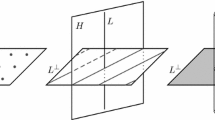Abstract
A new type of cutting plane, termed a decomposition cut, is introduced that can be constructed under the same assumptions as the well-known convexity cut. Therefore it can be applied in algorithms (e.g. cutting plane, branch-and-cut) for various problems of global optimization, such as concave minimization, bilinear programming, reverse-convex programming, and integer programming. In computational tests with cutting plane algorithms for concave minimization, decomposition cuts were shown to be superior to convexity cuts.
Similar content being viewed by others
References
Balas, E. (1971), Intersection cuts-a new type of cutting planes for integer programming, Operations Research 19: 19-39.
Balas, E. (1972), Integer programming and convex analysis: Intersection cuts from outer polars, Mathematical Programming 2: 330-382.
Balas, E., Bowman, V.J., Glover, F. and Sommer, D. (1971), An intersection cut from the dual of the unit hypercube, Operations Research 19: 40-44.
Balas, E. and Burdet, C.A. (1972), Maximizing a Convex Quadratic Function Subject to Linear Constraints, Managment Science Research Report 299, Carnegie-Mellon University, Pittsburgh, PA.
Bulatov, V.P. (1990), Methods for solving multi-extremal problems (global search), Annals of Operations Research 25: 253-278.
Glover, F. (1973), Convexity cuts and cut search, Operations Research 21: 123-134.
Glover, F. (1974), Polyhedral convexity cuts and negative edge extension, Zeitschrift für Operations Research 18: 181-186.
Gurlitz, T.R. and Jacobsen, S.E. (1991), On the use of cuts in reverse convex programs, Journal of Optimization Theory and Applications 68: 257-274.
Hillestad, R.J. and Jacobsen, S.E. (1980), Reverse convex programming, Applied Mathematics and Optimization 6: 63-78.
Horst, R. and Thoai, N.V. (1989), Modification, implementation and comparision of three algorithms for globally solving linearly constrained concave minimization problems, Computing 89: 271-289.
Horst, R. and Tuy, H. (1996), Global Optimization (Deterministic Approaches), Springer, Berlin.
Konno, H. (1976), A cutting plane algorithm for solving bilinear programs, Mathematical Programming 11: 14-27.
Konno, H. (1976), Maximization of a convex quadratic function under linear constraints, Mathematical Programming 11: 117-127.
Konno, H. (1980), Maximizing a convex quadratic function over a hypercube, Journal of the Operations Research Society of Japan 23: 171-189.
Konno, H. (1981), An algorithm for solving bilinear knapsack problems, Journal of the Operations Research Society of Japan 24: 360-374.
Porembski, M. (1996), Schnittebenen für Probleme der Konkaven Minimierung und verwandte Optimierungsprobleme, doctoral thesis, Philipps-University, Department of Mathematics, Marburg, Germany.
Schrijver, A. (1986), Theory of Linear and Integer Programming, John Wiley & Sons, Chichester New York, Brisbane, Toronto, Singapore.
Sen, S. and Sherali, H.D. (1987), Nondifferentiable reverse convex programs and facial convexity cuts via a disjunctive characterization, Mathematical Programming 37: 169-183.
Sherali, H.D. and Shetty C.M. (1980), A finitely convergent algorithm for bilinear programming problems using polar cuts and disjunctive face cuts, Mathematical Programming 19: 14-31.
Tuy, H. (1964), Concave programming under linear constraints, Soviet Mathematics 5: 1437-1440.
Tuy, H. (1991), Normal conical algorithm for concave minimization over polytopes, Mathematical Programming 51: 229-245.
Vaish, H. and Shetty, C.M. (1977), A cutting plane algorithm for the bilinear programming problem, Naval Research Logistics Quarterly 24: 83-94.
Young, R.D. (1971), Hypercylindrically deduced cuts in zero-one integer programming, Operations Research 19: 1393-1405.
Zwart, P. (1971), Computational aspects of the use of cutting planes in global optimization, Proceedings of 1971 Annual Conference ACM, pp. 457-465. Address for correspondence: MarcusPorembski, Philipps-Universität, FB02-InstitutfürWirtschaftsinformatik, Universitätsstr.24,35032Marburg,Germany(e-mail:porembsk@wiwi.uni-marburg.de).
Author information
Authors and Affiliations
Rights and permissions
About this article
Cite this article
Porembski, M. How to Extend the Concept of Convexity Cuts to Derive Deeper Cutting Planes. Journal of Global Optimization 15, 371–404 (1999). https://doi.org/10.1023/A:1008315229750
Issue Date:
DOI: https://doi.org/10.1023/A:1008315229750




